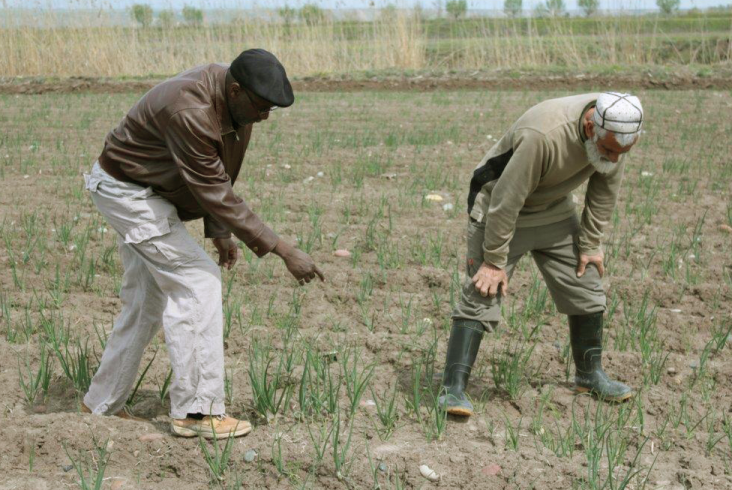
The smallholder palm oil farmers of Foya, Liberia are survivors. They endured a 14-year civil war, which ended in 2003, and resulted in the loss of hundreds of thousands of lives, homes, and infrastructure. This demolished the morale and productivity of the farmers, and left them using inefficient methods that wasted water. But one decade later, these farmers were ready to learn new skills and restore their livelihoods so they could better feed their families.
David Speidel of Missouri is also a survivor. A proud grandfather who comes from a long line of farmers, he is a veteran of the U.S. Army. After losing a friend on the battlefield in Iraq in 2007, he was driven to use his skills as an agricultural advisor specializing in irrigation to improve the world.
Mr. Speidel and these Liberian farmers were brought together in 2013 through USAID’s Farmer-to-Farmer program. The 29-year-old program has sent more than 16,000 American volunteers like Mr. Speidel to more than 110 countries to teach farmers key skills to help them boost productivity and better feed their families.
Cultivating Trust
“The Farmer-to-Farmer program reflects a range of our broader policy objectives,” said Gary Alex, Farmer-to-Farmer Program Manager at USAID’s Bureau for Food Security. These objectives include expanding trade opportunities, mobilizing science and technology, fostering innovation, building the capacity of farmers, and sustainably reducing global hunger and poverty. The program is part of Feed the Future, the U.S. Government's global hunger and food security initiative, which is led by USAID.
One of the best ways to achieve these goals is through on-the-ground one-on-one assistance. Unfortunately this model can be limiting and difficult to scale, both in cost and human resources. In addition, farmers are often reluctant to change their practices because the risks and the stakes – their lives and livelihoods – are high.
Farmer-to-Farmer addresses this by bringing highly skilled, motivated volunteers to hosts who have already expressed a desire to receive training. “Hosts typically are potential leaders in their field with interest and motivation to make changes and adopt innovation,” said Mr. Alex.
This mutual commitment makes the program uniquely effective. “Some hosts have said that they put more trust in volunteers than paid consultants, as volunteers are sharing experience freely and are not motivated by financial benefits,” said Mr. Alex. In addition, because the hosts are motivated community leaders, they are poised to effectively share their knowledge with others throughout the community, long after the volunteers leave.
Demonstrating Change
While projects have run the gamut from facilitating Guatemala’s first-ever artificial goat insemination to helping a Ghanaian livestock feed manufacturer develop a customer-oriented marketing strategy, water has been a common thread among many of them.
In Liberia, Mr. Speidel introduced low-cost micro-irrigation to farmers in palm oil nurseries. He conducted demonstrations of treadle pumps and a motor pump. These pumps can supply enough water to expand seedling production to at least 5,000 seedlings without increasing labor costs, and substantially lower production costs.
Exchanges like these have a ripple effect. When neighbors see improvements in the productivity of influential community members, they too want to learn new skills.
In Mali, for example, a volunteer worked with a farmers’ cooperative to demonstrate how to conserve water while boosting production by using drip irrigation and compost and by planting crops on raised beds. These farmers reported a 25 percent decrease in fertilizer use and a 35 percent increase in yields. With the support of the local mayor, the volunteer then created a demonstration plot to teach even more farmers the techniques. Fifteen hundred farmers have now visited the plot, and more continue to learn from it every day.
Bringing the World Home
The program is not just focused on improving lives abroad. “A secondary goal is to increase public understanding of international development issues and programs,” said Mr. Alex.
Volunteers are the key to this endeavor. Upon returning stateside, they write blog posts, share photos online, and regale their friends and neighbors with stories of overcoming challenges and teaching and learning from farmers in the field.
“Many continue to stay in touch with their hosts and sometimes raise funds or provide their own resources to assist hosts. Many also serve as repeat volunteers to the same or different countries,” said Mr. Alex.
As one of those repeat volunteers, Mr. Spiedel recalls facing numerous hardships in Liberia – unreliable electricity, bathing himself with a bucket at the well, and the occasional skipped meal due to lack of food. He said in-country project staff helped him navigate these challenges, and he has since volunteered in other countries around the world.
“Where else would you find yourself white-knuckled while careening along a narrow, hilly, curvy, pedestrian and moped packed road, flowing through one village market after another, with rubber and chocolate plantation groves lining the road, while listening to African Christian Gospel?” he recounted. “Without a doubt, my time in Liberia was incredibly fulfilling.”
C. Zeilberger







Comment
Make a general inquiry or suggest an improvement.